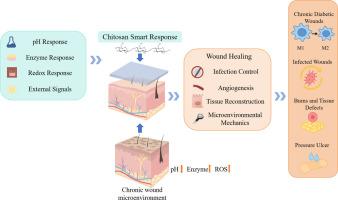Smart-responsive chitosan dressings: From microenvironmental sensing to multifunctional precision wound healing
IF 5.1
Q1 CHEMISTRY, APPLIED
引用次数: 0
Abstract
Wound healing constitutes a multifaceted and dynamically regulated process that is modulated by a variety of microenvironmental factors such as pH, enzymes, and reactive oxygen species (ROS). Conventional wound dressings frequently fail to deliver the precise interventions necessary for the effective management of complex wounds. Chitosan, characterized by its high biocompatibility, biodegradability, and structural adaptability, exhibits enhanced self-healing photoactivity, rendering it an ideal candidate for the development of smart, responsive wound dressings. This review systematically examines the design strategies, molecular mechanisms, and therapeutic applications of chitosan-based smart dressings. It emphasizes their roles in infection control, inflammation reduction, angiogenesis, and tissue regeneration. Furthermore, we underscore the importance of multimodal systems incorporating adaptive feedback mechanisms (pH/ROS combinations, pH/enzyme and ROS/photothermal coupling) and explore their clinical potential in the treatment of diabetic foot ulcers, pressure ulcers, and other complex skin injuries. These findings provide a detailed framework for the development of the next generation of bio-responsive materials, fostering the integration of materials science with personalized wound care strategies.

智能反应壳聚糖敷料:从微环境传感到多功能精确伤口愈合
伤口愈合是一个多方面的动态调节过程,受多种微环境因素如pH、酶和活性氧(ROS)的调节。传统的伤口敷料常常不能提供有效处理复杂伤口所需的精确干预措施。壳聚糖具有较高的生物相容性、生物降解性和结构适应性,具有较强的自愈光活性,是开发智能、反应性伤口敷料的理想候选材料。本文综述了壳聚糖智能敷料的设计策略、分子机制和治疗应用。它强调了它们在感染控制、炎症减少、血管生成和组织再生中的作用。此外,我们强调了结合自适应反馈机制(pH/ROS组合,pH/酶和ROS/光热耦合)的多模态系统的重要性,并探索了它们在治疗糖尿病足溃疡,压疮和其他复杂皮肤损伤方面的临床潜力。这些发现为下一代生物反应材料的开发提供了详细的框架,促进了材料科学与个性化伤口护理策略的整合。
本文章由计算机程序翻译,如有差异,请以英文原文为准。
求助全文
约1分钟内获得全文
求助全文

 求助内容:
求助内容: 应助结果提醒方式:
应助结果提醒方式:


